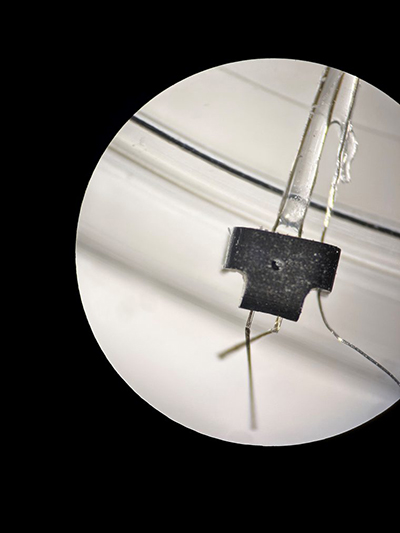
CREDIT: NANO DIMENSION
Nano Dimension Ltd., a leading supplier of additively manufactured electronics (AME) and multi-dimensional polymer, metal & ceramic additive manufacturing (AM) 3D printing solutions, has partnered with leading research centers in Canada and France on a breakthrough project using its precise Fabrica micro-3D printing systems. The study centers around the accurate recording of neuronal activity in mice, with the aim to elucidate the neuronal circuits and mechanisms involved in the processing of somatosensory information. The results of the project underscore the vital role played by innovative manufacturing solutions in the advancement of biomedical research and the development of cutting-edge medical devices.

The intricacy of the design challenge required precise
dimensions, including 110µm holes for electrodes
in a part that was merely 2.7mm in width.
According to the research team, which comprised researchers from three leading institutions, small or micro medical devices for research project purposes pose significant challenges in production due to their size, dimensional requirements, and intricate features. In this instance, the team needed to design a miniature brace capable of securely holding two electrodes on the vertebra of the mouse. To date, limited attempts have been made to explore the electrical activity of dorsal horn neurons in awake animals, which presented its own challenges for the team.
“Recording the electrical activity of neurons in the spinal cord of a conscious animal is not easy, mainly due to the movements induced by walking and breathing of the mouse, as well as the accessibility of the area in question,” explains Louison Brochoire, a PhD student at the University of Bordeaux in France.
“For this project, we needed the brace to allow movement of the animal while firmly securing and stabilizing electrodes that were inserted into very minute holes,” adds Brochoire, who worked under the supervision of professors from Bordeaux’ Institut des Maladies Neurodégénératives, as well as from the CERVO Research Center and University of Laval in Québec, Canada.
Mindful that traditional manufacturing methods would involve a lengthy struggle to produce a device that could effectively stabilize electrodes in place while maintaining accuracy and functionality, the team partnered with Nano Dimension to find an alternative solution.
The intricacy of the design challenge required precise dimensions, including 110µm holes for electrodes in a part that was merely 2.7mm in width. This saw Nano Dimension deploy its Fabrica micro-3D printing technology, which provides unparalleled micron-level precision. Using its Fabrica 3D printers, which produce accurate and functional parts with tight tolerances and a pixel size as small as 4µm and a layer height of between 1-10µm, the company was able to successfully 3D print the required brace. This provided a functional part for the team to use in their research within just one week.
For the research team, the result met their requirements exactly. “The ability to create such precise and minute holes within the brace was critical,” says Brochoire. “This design attribute helped to minimize artifacts caused by breathing and movements of the animal, which would interfere with our electrical signal, complicating the analysis of results.”
To deliver a functional part that met the specific requirements for implantation into a mouse, Nano Dimension used its bio-compatible Fabrica Medical M-810 material. With its clearance for cytotoxicity, which ensures that it is not toxic to human cells, the material was the perfect fit for the device needed by the team.
“The high precision and resolution of Nano Dimension’s micro-3D printing technology, coupled with the use of biocompatible material, empowered us to create a new tool essential for achieving our primary objective. The alternative using other means would have involved printing and modifying a larger part to achieve the desired features. This could have taken several months, which for a research project would be a real issue. Clearly, the use of such technologies in the medical field will surpass many limitations,” Brochoire concludes.
As well as Louison Brochoire, the other members of the research team comprised Professor Pascal Fossat from the Institut des Maladies Neurodégénératives (IMN); Professor Yves De Koninck from Québec’s CERVO Research Center; Professor Benoit Gosselin from Québec’s University Laval, Faculty of Science and Engineering, Department of Electrical and Computer Engineering; and Juliette Viellard, Post Doctoral Researcher from the University of Bordeaux
Latest from Today's Medical Developments
- Arcline to sell Medical Manufacturing Technologies to Perimeter Solutions
- Decline in German machine tool orders bottoming out
- Analysis, trends, and forecasts for the future of additive manufacturing
- BlueForge Alliance Webinar Series Part III: Integrate Nationally, Catalyze Locally
- Robot orders accelerate in Q3
- Pro Shrink TubeChiller makes shrink-fit tool holding safer, easier
- Revolutionizing biocompatibility: The role of amnion in next-generation medical devices
- #56 Lunch + Learn Podcast with Techman Robot + AMET Inc.





